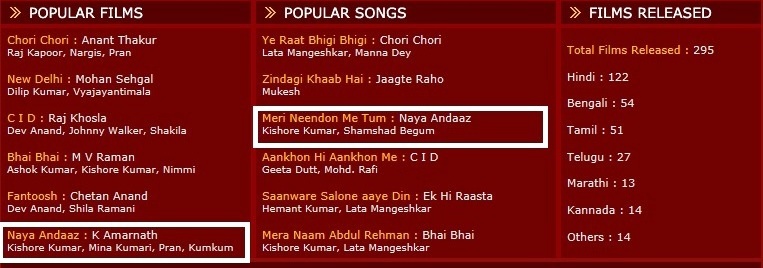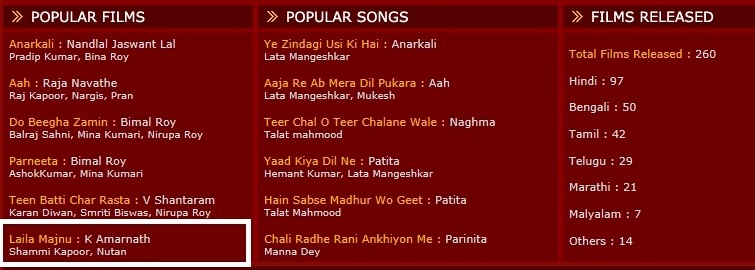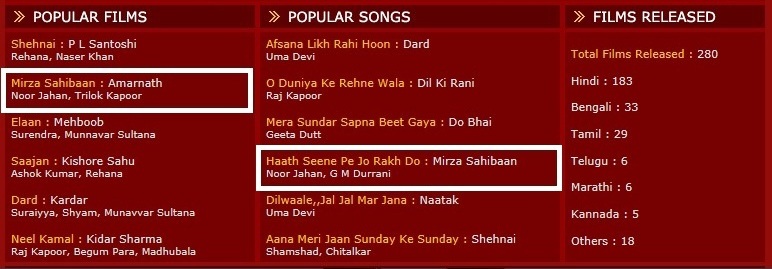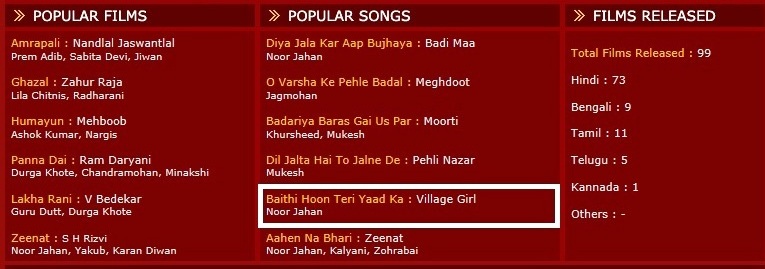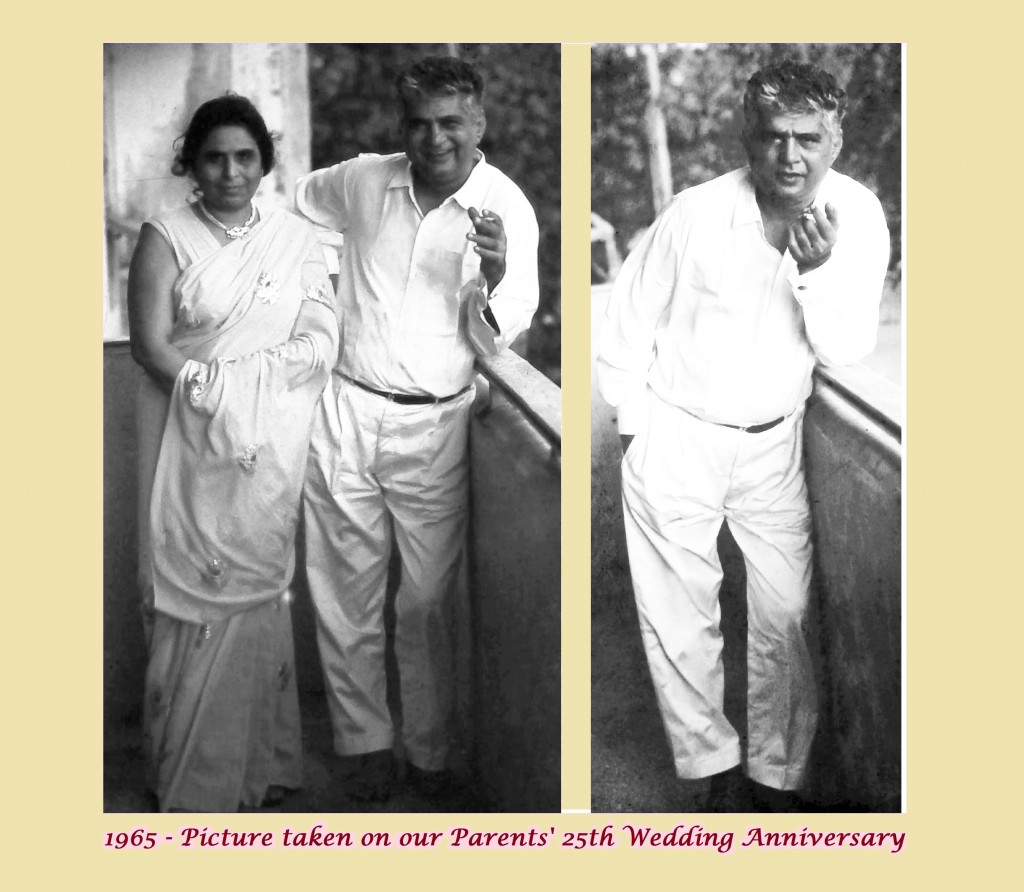
Today is 1st December, 2013
Our dad, K.Amarnath would have been 99 years old today
In His Remembrance
I have added this new Post titled,
“1st December 2013 – More From The Web”
Sharing some interesting facts and articles from various websites
&
Song reviews from “Atul’s Song A Day”


http://www.torrentreactor.net/torrents/6026937/Mirza-Sahiban-1947-Phantom-DaX-desibbrg-com
“Mirza Sahiban is a 1947 Historical drama directed by
The Golden Era Stalwart K.Amarnath
with lead roles by Noor Jehan & Trilok Kapoor.”
——————————————————————————
“Stalwart” – absolutely – for indeed my dad was one!
Powerful * Strong morally & physically * Solid & Dependable
Resolute & Firm * Steadfast & Uncompromising
A Leader with imposing physical strength * Undaunted * Accustomed to fatigue and hardships
Loyal – Brave – Courageous & Fearless
http://www.hindustantimes.com/Brunch/Brunch-Stories/India-in-the-1940s-The-way-we-were/Article1-1106116.aspx
India in the 1940s: The way we were – Hindustan Times
Memory is a powerful thing.
When we look six decades back, we’re filled with an unparalleled sense of pride at the epic movements of history that brought us to this stage. But what about the little details? We gathered fragments – stories from people’s lives, clippings from old newspapers and photographs from dusty albums and strung them together to bring you an essence of how we lived from 1940-9 ………..
(RE) CINEMA, CINEMA, CIRCA 1947
3. MIRZA SAHIBAN
Cast: Noor Jehan, Trilok Kapoor – Director: K Amarnath
Music: Pandit Amarnath and Husnlal Bhagatram
Synopsis: Mirza, once the naughtiest boy in the village, falls in love with Sahiban. But Mirza’s arch enemy is also head-over-heels in love with Sahiban and is irked that she prefers Mirza. He takes advantage of village gossip to fuel Sahiban’s brother’s anger against the couple. They are forced to separate. The couple try to get back together, but like all old love stories, their love is doomed. Watch it for: The beautiful music and Trilok Kapoor (Prithviraj Kapoor’s brother and a thoroughbred Kapoor). See it as a precursor to Bollywood’s affair with classic love stories such as Heer Ranjha and Sohni Mahiwal.
Four of the movies directed by K. Amarnath
Naya Andaz, Laila Majnu, Mirza Sahiban & Gaon ki Gori (Village Girl)
were in the “Top 6 Popular Films & Popular Songs Charts” of
1956, 1953, 1947 & 1945 respectively
as per http://downmelodylane.com/
http://downmelodylane.com/dty1956.html
1956
http://downmelodylane.com/dty1953.html
1953
http://downmelodylane.com/dty1947.html
1947
http://downmelodylane.com/dty1945.html
1945
http://www.youtube.com/watch?v=RsYN7xYrj5E
Shamshad Begum (April 14, 1919 – April 23, 2013)
Interview 2/2
Shamshad Begum, at the age of 70, sings her popular song
“Meri Neendon Mein Tum” from K.Amarnath’s 1956 movie “Naya Andaz” acappella ! (without any musical accompaniment)
http://www.downmelodylane.com/shamshad.html
“Her duet with Kishore Kumar, ‘Meri Neendon Mein Tum..’ from Naya Andaz, remains almost a touchstone of melodious romance!”
(5 mts. into the interview- part 2 – please click on the YouTube link above )
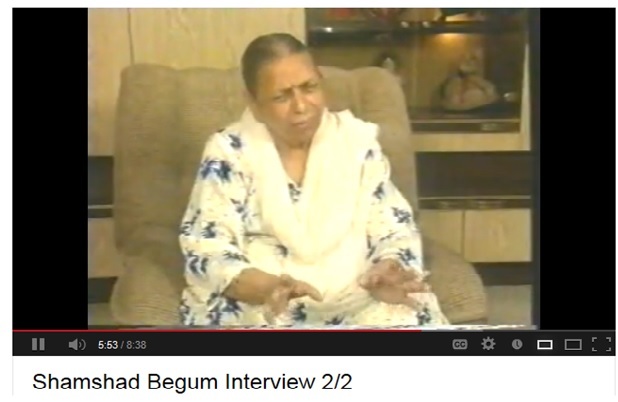
Stills from K. Amarnath’s movie “Alif-Laila” (1953)
http://www.tasveergharindia.net/cmsdesk/essay/103/index_1.html – By Rosie Thomas
http://www.tasveerghar.net/cmsdesk/essay/85/ – The Priya Paul Collection of Popular Art
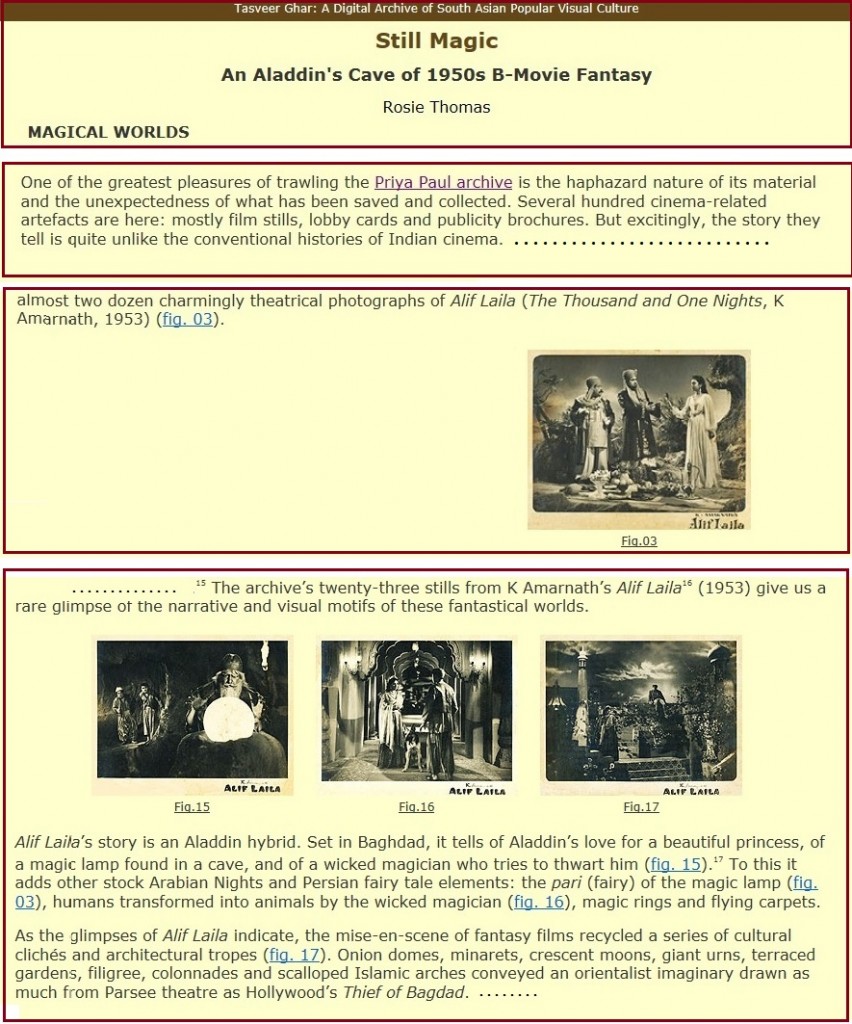
K. Amarnath Movie Songs: Links & Excerpts from Articles as discussed in
the Amazing Website : “Atul’s Bollywood Song a Day-with full lyrics”
http://atulsongaday.me/
“This blog (atulsongaday.me) discusses Bollywood songs of yesteryears. Every song has a brief description, followed by a video link, and complete lyrics of the song.
This is a labour of love, where “new” songs are added every day, and that has been the case for more than five years.
This blog has over 9000 songs by now.”

Bada Admi – 1961
http://atulsongaday.me/2013/11/13/ankhiyan-sang-ankhiyaan-laagi-aaj/
Posted by: Atul on: November 13, 2013
This article is written by Sudhir Kapur, a fellow enthusiast of Hindi movie music and a regular contributor to this blog………
…………Welcome all to the magical 9000th milestone in this merry musical journey ……….
….. on this blog, it is an effort that is being attempted on a grand scale that has no peers anywhere on the internet. Every song is accompanied by full lyrics, added to which is a very well researched information package about the demographic details of the song. Each song is accompanied by a full write up that talk about so many aspects of the film song, the artists and performers and about the life and culture itself. ……
……. Just keeping up the tradition that the 5000th song happened on 13th November, 2011, the 7000th song happened on 13th November, 2012 and now today, it is the same date again, and we are hitting the 9000th post. ……
Ah, yes, you are thinking correctly. We are also celebrating another milestone, as we always do. With this song, the tally of Rafi Sb’s songs has now reached 2100. A very befitting tribute and a very befitting honor for an artist who has had no equal, both as a singer and as a human being………..
Atul ji and I have been back and forth many times trying to locate a befitting song for this occasion. There were no significant anniversaries, no significant individual milestones, no special events for 13th November. It was becoming difficult to locate an appropriate song for this occasion. Yesterday afternoon, as we were discussing, he suggested Rafi Sb’s name saying that he is close to the 2100 milestone. My mind immediately started to look for a song to fit the bill……. I went over many lists, browsed through the YouTube and shortlisted some songs. But none was really satisfying. The songs shortlisted are of great quality, but somehow my mind kept telling me – it has to be even better, the milestone is really major.
I chanced upon another list in file on my laptop, which contains some important favorites. Browsing through this list and then side by side checking with the blog list for already published songs, I came to this song. And my mind suddenly was taken by surprise – what, this song is not yet posted? And the decision was immediate.
A song in the semi classical genre, it belongs to the same category that consists of such marvelous gems like Rafi Sb’s “Madhuban Mein Radhika Naache Re” and Manna Da’s “Laaga Chunri Mein Daag Chhupaaun Kaise”. How has this song escaped the notice of all of us – well that is no longer a mystery. Just the fact that the ocean of Hindi film songs is still so vast and unexplored that many such valuable treasures are still sitting out there, waiting to be rediscovered.
The film is ‘Badaa Aadmi’ from 1961. It is a K Amarnath production … film, directed by Kaushal Raj. The film has 6 songs, all of them carrying the classic hallmark of Chitragupt’s wizardry, and the lyrical beauty of Prem Dhawan’s quill. Three of the songs are already posted here. This is the fourth song to be showcased from this film. And the remaining two songs, I promise you, are no less wonderful. A less heard about film, carrying a treasure of musical gems – as usual.
The song is a stage performance. ………….
A song that is so beautifully crafted – the words, the melody and the rendering – it is all so chaste.
It is a lovely pleasure to listen to.
And as well equally a pleasure to watch, it has been performed so well……………….
![]()
SUBI RAJ – VIJAYA CHOWDHARY
ANKHIYAN SANG ANKHIYAAN LAAGE AAJ
DIRECTED BY KAUSHAL RAJ BATRA

Bada Admi – 1961
Kabli Khan – 1963
http://atulsongaday.me/2011/03/23/chalo-jhhoomte-sar-se-baandhe-kafan/
This article is written by Sudhir, a fellow enthusiast of Hindi movie songs and a regular contributor of articles to this blog. (Atulsongaday)
The name of Bhagat Singh evokes strong emotions in the hearts of all Indians. This great son of Punjab laid down his young life fighting for the independence of India from the rule of the British aggressors.Bhagat Singh was born on September 27, 1907 to Sardar Kishan Singh and Vidyavati in the Khatkar Kalan village in district Layallpur in of undivided Punjab (now in Pakistan). Many senior members of his family were part of the Gadar party, and the spirit to fight the British was inherited in his blood. He started studying at the National College in Lahore, but ran away from home to escape early marriage, and became a member of the Naujawan Bharat Sabha (“Youth Society of India”). After the brutal killing of Lala Lajpat Rai in a lathi charge by the British police, he swore to take revenge on Inspector Saunders who led the police team in that action. With his fellow revolutionaries he carried out this revenge and then escaped from Lahore in a disguise. He continued his revolutionary activities, which culminated in the bombing of the constituent assembly in Delhi.
On April 8th, 1929, he and his associate, Batukeshwar Dutt threw bombs in the assembly, in protest against two bills to be passed that day, which were anti India. This time he did not attempt to escape. He was arrested, and after a mock trial by the British, he and his two colleagues, Rajguru and Sukhdev were sentenced to death by hanging. The sentence was carried out on this day (23 march ) in 1931, when he was just 24 years old.
The song in this post is so very appropriate for the life and sacrifice of this great son of India.
It is from the 1963 movie, Kabli Khan.
The inspiring lyrics are by Majrooh Sultanpuri and the rousing composition is by Chitragupt.
The song is wonderfully rendered by Lata, and is picturized on Helen.
The soldiers in the scene join in the chorus for this song.
On-screen, one sees a completely different image of Helen, than the one we are generally familiar with. She is singing the song with a gun in her hand. The situation is a sort of military get together and Helen is performing and singing this song. Other actors one can identify in the clip are Jayant and Ajit. Jayant is a dictator whose cruel treatment of his people has made him a object of hate, and there is a revolution brewing against him. In this scene, the army is of the soldiers who are loyal to him. Ajit and Helen are revolutionaries who have infiltrated his army in disguise, and Ajit has gained the confidence of Jayant, and is planning his next move.
In the scene just before this song, Ajit and Helen have a secret meeting, and discuss the plan to overthrow Jayant; the action is to be initiated on the day. After that interlude, this song is presented. Jayant is visibly perplexed by the tone and words of the song, as Helen is making an effort to exhort the officers of Jayant’s army, reminding them of what their country means to them and what is their duty towards it.
The words of the song are brilliant and inspiring, and so appropriately depict the very values and sentiments associated with the supreme sacrifice of Bhagat Singh. Every time that I listen to this song, it makes my eyes wet, and my heart is filled with gratitude and honor for Bhagat Singh and other such sons of India who laid down their lives so that we could live and breathe in a free country.
HELEN – AJIT – JAYANT
CHALO JHUMTE SAR SE BAANDHE KAFAN
DIRECTED BY K.AMARNATH

Kabli Khan – 1963
Bara-Dari – 1955
http://atulsongaday.me/2012/04/09/dard-bhara-dil-bhar-bhar-aaye/
I first became aware of the movie “Baradari” (1955) sometime in mid 1970s when I was trying to become a well rounded music lover by listening to old songs. The song that made me aware of this movie was the song Tasweer banata hoon tasweer nahin banti. To this day, I associate this movie with this song. It was with this movie that I became aware of a music director called Nashaad (not to be confused with Naushad) and also with a lyricist called Khumar Barabankwi.
When one listens to the songs of this movie, one cannot but help feel that this movie was perhaps the high point in the careers of both Nashaad and Khumar Baranabankwi. What superb songs this movie had !
Apart from the above mentioned Talat Mehmood song, this movie also had the lovely Talat Lata duet viz. Bhula nahin dena ji bhula nahin dena .
I have discussed as many as four songs from this movie in the past. Here is another song from this movie. This song is a Lata solo. It is picturised on Geeta Bali. The song, which is about waiting patiently for the beloved has superb lyrics. “sabar ka daaman chhot na jaaye” (do not give up on patience), the recurring phrase of this song is just as relevant even today.
GEETA BALI
DARD BHARA DIL
DIRECTED BY K.AMARNATH
Bara-Dari – 1955
http://atulsongaday.me/2009/01/09/tasweer-banaata-hoon-tasweer-nahin-banti/
This is one of the most memorable song sung by Talat Mahmood.
….. From the movie “Baradari” ………
What is it that makes this song such a timeless classic ?
I think it is the X factor.
The lyrics are simple looking and the music is soft, and the voice is in any case known for being soft and mellow and silken. The combination has worked well and this song as a result has gone on to become such a well known and much loved song.
CHANDRA SHEKHAR
TASVEER BANATA HOON
DIRECTED BY K.AMARNATH
Bara-Dari – 1955
Naya Andaz – 1956
http://atulsongaday.me/2009/02/27/meri-neendon-me-tum/
There are actors who are known for playing happy go lucky roles and there are actresses who are known for playing melancholic roles. How to make these actresses play cheerful roles — make them act in the same movies in which the cheerful happy go lucky actor is also acting.
Meena Kumari got to act in quite a few movies in which Kishore Kumar was also acting. And one must say it had salutary effect on Meena Kumari. In these movies she played happy, bubbly characters and as a result these movies turned out to be much loved movies.
“Naya Andaz” (1956) was one movie where Kishore Kumar and Meena Kumari, acted opposite each other. ———
O P Nayyar is the music director and Jaan Nissar Akhtar wrote the lyrics.
This song is a beautiful soft romantic number sung by Kishore Kumar and Shamshad Begum. —-
KISHORE KUMAR – MEENA KUMARI
MERI NEENDON MEIN TUM
DIRECTED BY K.AMARNATH
Naya Andaz – 1956
http://atulsongaday.me/2010/12/07/chanaa-zor-garam-babu-main-laayaa-mazedaar/
A chana jor garam song was first created in Hindi movies as way back as in 1938 ……………….Two decades later, another fantastic chana jor song was created. and this song is the topic of discussion here. This song is a stage song, sung by Kishore Kumar and Shamshad Begam. This fantastic comedy song is picturised on Kishore Kumar and Meena Kumari.
This song is written by Jaan Nissar Akhtar and its music is composed by O P Nayyar.
Listening to this song (and watching the picturisation) will make your day.
MEENA KUMARI – KISHORE KUMAR
CHANA ZOR GARAM BABU
DIRECTED BY K.AMARNATH
Naya Andaz – 1956
Alif-Laila – 1953
http://atulsongaday.me/2010/07/13/mere-naghmon-mein-in-mastaana-aankhon-ki-kahaani-hai/
………………what A grade music this movie had !
I have discovered some half a dozen superb songs in this movie that I am going to post ……..
Here is one of these songs. This song is sung by Talat Mehmood and it is picturised on Vijay Kumar as a “roadside tamasha” song. The song is written by Sahir Ludhianvi and music is composed by Shyam Sundar.
What a nice song it is ! ………..
VIJAY KUMAR – GOPE
MERE NAGMO ME UN MASATANA
DIRECTED BY K.AMARNATH
Alif-Laila – 1953
Bazar – 1949
http://atulsongaday.me/2011/08/15/shaheedon-tumko-mera-salaam/
Posted by: Atul on: August 15, 2011
This aricle is written by Sudhir, a fellow enthusiast of Hindi movie songs and a regular contributor to this blog.(Atulsongaday)
Greetings to all, on the 64th anniversary of Independence. A day to be remembered. And more than the day, it is important to remember those who laid down their lives to make this freedom possible.
This song is to honor and pay homage to all those brave men and women of India, who took to the streets and defied the oppressive rule of the British power. They sacrificed their personal comforts, the comforts of their loved ones and their family, they sacrificed their careers and other pursuits and some even made the ultimate sacrifice of their lives………..
The words and the music is very simple and touching.
Rafi Saab has rendered this song so very simply,
and yet, there is a tingle that runs down the spine, as one listens to it.
SHYAM – NIGAR SULTANA
SHAHEEDO TUMKO MERA SALAAM
DIRECTED BY K.AMARNATH
Bazar – 1949
Beqasoor – 1950
http://atulsongaday.me/2010/05/30/khabar-kisi-ko-nahin-wo-kidhar-ko-dekhte-hain/
….Unlike qawwaalis of the later years where male and female singers would both sing, this is an all male qawwali. Here one can listen to the voices of Rafi, G M Durrani and Mukesh. It is the first time I heard the voice of Mukesh singing a qawwali and I must say that I was pleasantly surprised by Mukesh’s ability to hold his own in this song……
In any case,
I believe that this qawwali must be regarded as one of the finest qawwalis in Bollywood movies.
I consider myself fortunate that I managed to discover it.
I am sure my readers will enjoy listening (and watching) this qawwali too.
AJIT
KHABAR KISI KO NAHIN – DUAAYE MANG RAHEIN HAIN
DIRECTED BY K.AMARNATH
Beqasoor – 1950
Ishaara – 1964
http://atulsongaday.me/2010/09/25/chal-mere-dil-lehraa-ke-chal/
This movie is set on the backdrop of Delhi and the songs give us a liberal view of the landmarks of Delhi.
This song is a fantastic song.
It shows Joy Mukherji riding a bicycle and singing away joyously, with the landmarks of Delhi visible in the background.
Mukesh has sung this song with his usual Midas touch.
Majrooh Sultanpuri is the lyricist and Kalyanji Anandji have composed the music.
This song is a fantastic song. It is a gem that lies forgotten but which deserved to be much better known.
JOY MUKHERJEE
CHAL MERE DIL
DIRECTED BY K.AMARNATH

Ishaara – 1964
Kal Hamara Hai – 1959
http://atulsongaday.me/2009/05/17/ye-sachh-hai-ai-jahhan-waalon/
.
Posted on: May 17, 2009 …… Listening to this song for the first time today, half a century after this song was first recorded. I must say I liked the song.
And I am sure there are many people who will love listening to this song.
BHARAT BHUSHAN – MADHUBALA
YEH SACH HAI AI JAHAN VALO
DIRECTED BY S.K.PRABHAKAR

Kal Hamara Hai – 1959
Gaon ki Gori – Village Girl – 1945
http://atulsongaday.me/2009/09/21/ye-kaun-hansaa-kisne-sitaaron-ko-hansaayaa/
Here is a nice song from long long ago. This movie is called “Village girl” aka “Gaaon ki Gori” (1945).
This song had Noorjahaan in title role. She acts, and sings her own songs, as was the practice those days.
Here is a memorable song from this movie.
….there is no mistaking the fact that this song is a lovely song to listen to.
Wali Saahab is the lyricist and music is compposed by Shyam Sundar.
NOOR JEHAN
YEH KAUN HANSA – KISNE SITARO KO HASAYA
DIRECTED BY K.AMARNATH

Gaon ki Gori – Village Girl – 1945
http://atulsongaday.me/2013/05/06/kis-tarah-bhoolega-dil-unka-khayaal-aaya-huaa/
This article is written by Sadanand Kamath, a fellow enthusiast of Hindi movie music and a regular contributor to this blog.(Atulsongaday)
……………….Thereafter Lata Mangeshkar did not sing under his music direction until ‘Alif Laila’ (1953), his last film. During the making of this film, Lata Mangeshkar received a message fom Shyam Sundar that he had composed a tune especially for her. The song was tujhko bhulaanaa mere bas mein nahin which became her last song sung for him as he died during the making of ‘Alif Laila’. Madan Mohan completed the music for this film without taking any credit for his work. Notwithstanding her problems with Shyam Sundar, Lata Mangeshkar considered him to be one of the finest music directors she worked with. His song composition had a Punjabi flavour but with a distinct style of melody and liveliness in the songs.
During the golden jubilee celebrations of Indian films in 1982, a show was organised in Shanmukhanand Hall in Bombay (Mumbai) in which Noor Jahan rendered one of her immortal songs aawaaz de kahaan hai duniya meri jawaan hai from ‘Anmol Ghadi’ (1946) composed by Naushad to the thunderous applause of the audience. When Lata Mangeshkar’s turn came for singing, she chose to sing one of Shyam Sundar’s composition saajan ki galiyaan chhod chaley from the film ‘Baazar’ (1949) to an equally thunderous applause. When Noor Jahan’s next turn came for singing, she chose baithhi hoon teri yaad ka lekar ke sahaara from the film ‘Village Girl’ (1945) also composed by Shyam Sundar. Probably, they may have decided to sing these two songs as their tribute to a genius music director Shyam Sundar on the occasion. That these two songs also got tremendous appreciation from the audience nearly 4 decades after they were composed speaks volumes about the timelessness of Shyam Sundar’s compositions.
I have chosen for discussion an equally melodious song ‘kis tarah bhoolegaa dil unka khayak aaya huaa’ from the film VIILAGE GIRL (1945), which is sung by Noor Jahan. The song was penned by Wali Sahab and set to music by Shyam Sundar. The synopsis of the film was given in a post while discussing another song ajee dil ho qaaboo mein to from this film. In the film, Noor Jahan sings this song in the context of her beloved (Nazir) having not yet returned after joining the army as promised by him and her marriage is being fixed with the villain.
(Three of the movies mentioned in the above article, namely, Alif Laila – Bazar – Village Girl, were all directed by my father, K.Amarnath)
NOOR JEHAN
KIS TARAH BHULEGA DIL UNKA KHAYAAL AAYA HUA
DIRECTED BY K.AMARNATH

Gaon ki Gori – Village Girl – 1945
Mirza Sahiban – 1947
http://atulsongaday.me/2013/02/20/rut-rangeeli-aayi-chaandni-chhaayi/
This article is written by Sadanand Kamath, a fellow enthusiast of Hindi movie music and a regular contributor to this blog.
I was aware of four popular folklores of Punjab-Sind provinces which are now in Pakistan
– Heer Ranjha, Mirza Sahiban, Sohni Mahiwal and Sassi Punnu.
These are the tragic love stories in which the lovers die at the end.
The common features of all these four folklores are
(i) the female character is extremely beautiful,
(ii) families of both the lovers resent their unions,
(iii) female lovers are forced by their families to marry other man and
(iv) at the end, female lovers die first followed by the male lovers
except in case of Mirza Sahiban where the two lovers die in the reverse order.
The titles of three of these four stories start with name of the female lover while the title of ‘Mirza Sahiban’ starts with the name of the male lover. Whether there was a method in giving the titles or they happened to be known just like that is a moot point. But there seems to be a method in these titles as I observe that titles of these folklores begin with the names of lovers who died first in the story.………….
Mirza Sahiban (1947) was one of the films based on the folklore by the same name which I had watched on VCD a few months back. The film was produced under the banner of Madhukar Pictures and directed by K Amarnath. Trilok Kapoor and Noorjehan were the lead pair in the title role of Mirza and Sahiban respectively. Other cast included Roop Kamal, Amir Bano, Gope, Baby Anwari, Cuckoo etc. The film was one of the greatest hits of 1947. …………………………..
The song has a superb dholak accompaniment which reminds me of Punjabi Tappe folk music……………
Enjoy this cute and well picturised song.
NOOR JEHAN – TRILOK KAPOOR
RUT RANGEELI AAYI CHANDANI CHAYI
DIRECTED BY K.AMARNATH

Mirza Sahiban – 1947
http://atulsongaday.me/2011/06/28/tum-aankhon-se-door-ho/
Mirza Sahiban” (1947) is a movie that was released in 1947, in the year of Indian independence and partition.
This movie was one of the last occasions where Noorjahaan was seen in an Indian movie before she left for the newly created Pakistan.
“Mirza Sahiban” (1947) as the name suggests, is a Punjabi tragic love story. Trilok Kapoor and Noorjahaan played the title roles in this movie.
This movie is full of some superb songs………………………..
…………it is a superbly sung song that can move the listeners even today, more than six decades later.
NOOR JEHAN – TRILOK KAPOOR
TUM AANKHON SE DUR HO
DIRECTED BY K.AMARNATH
Mirza Sahiban – 1947
http://atulsongaday.me/2011/06/21/saamne-galli-mein-mera-ghar-hai/
There have been many movies, Hindi as well as Punjabi on the story of Mirza Sahiban. One of the first such Hindi movie was “Mirza Sahiban” (1947). ……
Here is a delightful song from this movie ……
…..this song is sung by Zohrabai Ambalewaali. It is picturised on several ladies and it is lip synced by Cuckoo. ……….
Aziz Kashmiri is the lyricist. The music of this movie is credited to Husnlal Bhagatram as well to their elder brother Amarnath. I am not aware what was the distribution of songs among them. It appears that it was a team work and giving individual credits for individual songs may not be possible. However, here I have credited Husnlal Bhagatram as the music directors of this song. The song certainly has the kind of lilting music that the two introduced in Hindi movies.
SAAMNE GALI MEIN MERA GHAR HAI
DIRECTED BY K.AMARNATH

Mirza Sahiban – 1947
http://atulsongaday.me/2011/05/15/aaj-miyaan-jee-ko-chadh-aaye-bukhaar-to-badaa-mazaa-aaye/
………. considering that this is one of the four major tradional Punjabi tragic love stories, one would normally expect to have love songs (tragic or otherwise) in a movie like this.
So I am pleasantly surprised to find that this movie has a light hearted song as well.
……. My guess is that Miyaan jee (who could be the school teacher of kids) is a strict disciplinarian and school kids are hoping that he gets sick so that they could have a day when they would not be required to study. This has been every school kid’s dream for generations, but such fond wishes rarely get fulfilled. In this song, kids fervently make their wish, and interestingly enough, …(their wish is)… granted !
Here is this cute song from “Mirza Sahiban”(1947).
The song is sung by Shamshad Begam, G M Durrani and chorus. Aziz Kashmiri is the lyricist. This movie had music by Husnlal Bhagatram as well as their elder brother, viz Pt Amarnath. The distribution of workload among them is not clear, so I have credited all of them as the music director for this song.
Some of the words/ sentences are not clear to me. I request my readers (with) keener ears to provide the correct words/ sentences at the places in lyrics where I have been unable to get them right.
PS-As I had thought, there is much Punjabi culture involved in the play that the kids indulge in after they find the happy news of Miyaan jee falling sick.
Sudhir, who has a first hand knowledge of this play, having played it in his childhood had given a detailed explanation of it, which I quote here.
In this song, after the news about Miyaan jee being actually sick, is received, the children are playing a game that is popular with kids in north India. It is called “Kiklee”, and as one can see in the video clip, two children will holds hands, such that it makes a cross for more stability, and then pirouette in a circle for as long as they can sustain it. Each child is actually pulling outwards, but because of opposing forces, they hold in balance and go around in circles almost effortlessly. It is a very exhilarating exercise; I know, I have played it.
In some movies, one may recall this game being played sometimes on the occasion of a wedding dance, or in as a side item in a village scene. And mind you, this is not limited to kids only, it can be played by elders too.
There is a small jingle that goes with this game, which the kids are singing in this video clip, as they are playing. The jingle goes like this.
kiklee kaleer di
chhaj bade peer di
bhai mera laayega
bhabi ko khilaayega
bhabhi meri royegi
dupatta mera dhoyegi
aayega dupatta mera
ab ke chade chet mein
odh ke dupatta kabhi
jaaungi na khet mein
tera mera pyaar aaj bas bas bas
It sounds like a nonsense rhyme for a game, but it is actually very eloquent, and full of traditional meanings. I will try to translate it below.
Kiklee kaleer di == Kiklee of kaleer – name of this game
Chhaj bade peer di == Prasad from a learned saint
Bhayee mere laayegaa == My brother will bring
Bhaabhi ko khilaayega == Will give it his wife, my bhabhi, to eat
Bhabhi meri royegi == My bhabhi will cry
Dupatta mera dhoyegi == My bhabhi will wash my dupatta. Dupatta is the Punjabi word for chunri, part of a salwar kameez dress worn on the shoulders.
Aayega dupatta mera Ab ke chade chet mein == I will be getting a new dupatta in the second half of the month of Chaitra.
The month of Chaitra is the called Chet in Punjabi; chade chet means the two weeks period of waxing moon in the month of chaitra, which is the second half of the month, as per the Hindu calendar. The significance of the timing is that by this time, the farmers have harvested the crops and have more money to bring gifts for their family. This is also the time of the Chaitra Navratri, when the families worship the Mother Goddess and the girl children are offered new dupattas. For grown up girls, there is an added significance. Getting a set of new dupattas during this time, means that preparations for her wedding are forthcoming.
Odh ke dupatta kabhi Jaaungi na khet mein == Again a very traditional touch, meant more for grown up girls; if she is of the age that she must wear the dupatta, then she may not venture out alone in the fields.
Tera mera pyaar aaj bas bas bas == Now my friendship with you must end today, for it is time for me to be wed and go to my in laws house.
Wow, now that I translated it,
I myself am surprised by the profundity of this jingle, that we just use to sing by rote, when we would play this game.
AAJ MIYANJI KO CHAD AAYE BUKHAR
DIRECTED BY K.AMARNATH

Mirza Sahiban – 1947
http://atulsongaday.me/2011/03/07/aaja-tujhe-afsaanaa-judaayi-ka-sunaayen/
Here is this nice pathos laden song from “Mirza Sahiban” (1947).
NOOR JEHAN
AAJA TUJHE AFSANA
DIRECTED BY K.AMARNATH
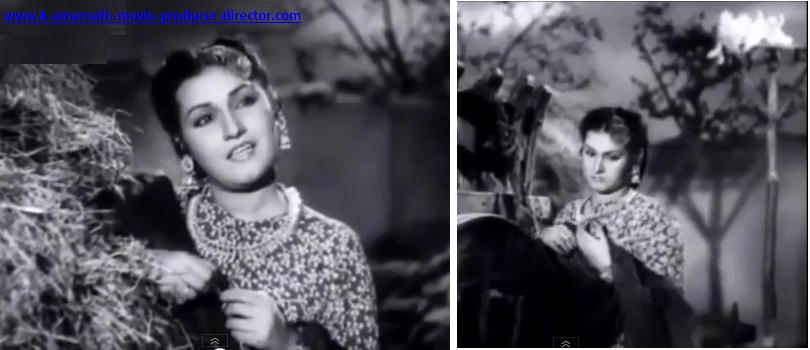
Mirza Sahiban – 1947
http://atulsongaday.me/2013/08/07/haaye-re-ud-ud-jaaye-mera-reshmi-dupattwa/
This article is written by Arunkumar Deshmukh, a fellow enthusiast of Hindi movie music and a regular contributor to this blog.
Today’s song is a real treat to the Connoisseurs.
It is a group song from the film MIRZA SAHIBAN-1947, sung by Malika-E-Tarannum Noorjahan, Zohrabai Ambalawali, Shamshad Begum and chorus. The music was provided by three brothers together- Pt.Amarnath and Husnlal-Bhagatram.
Today’s song depicts Sahiban with her sahelis, going for an outing. The music and the tune is so lovely that it will remain with you for a long time, I am sure.
So, enjoy this Gem from the 40s……
NOOR JEHAN
HAYE RE UD UD JAYE MORA RESHMI DUPATTVA
DIRECTED BY K.AMARNATH

Mirza Sahiban – 1947
![]()

![]()
MENU |
BACK TO TOP |

